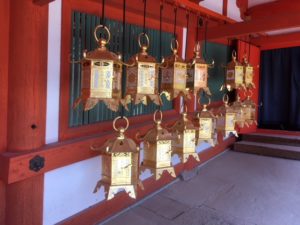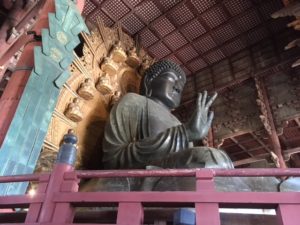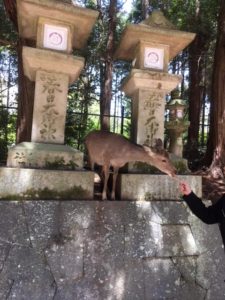
Gold lanterns light the way in one of Nara Park’s many shrines.
Seventh in a Series
Just an hour by train from Kyoto, Nara is a sometimes-overlooked jewel of a city that has played a key role in the historical and cultural life of Japan.
Often visited on day trips from Kyoto — certainly possible if you get an early start — Nara is well worth an overnight stay to keep from being too rushed. We stayed two nights and didn’t regret it, even though we had to change hotels after one night due to a booking error.
If you have more time, Nara is also a convenient base for exploring the surrounding countryside and villages filled with history, hot springs, and, in season, cherry blossoms.
Nara Park and World Heritage Sites
Japan’s first permanent capital during the 8th century AD before the imperial base was moved to Kyoto, Nara is home to eight UNESCO World Heritage Sites, including the renowned Todaiji Temple and its Great Buddha (Daibutsu), which also dates back to the 8th century.
It’s quickly apparent why it’s called the Great Buddha: One of the world’s largest bronze statues, it stands some 50 feet (15 meters) high, weighs nearly a million pounds, and dominates the Daibutsu-den Hall, itself one of the world’s largest wooden buildings.
The Great Buddha, in turn, is surrounded by smaller Buddhas and other Buddhist divinities, making for an unforgettable sight and one of Japan’s premier icons. Only Kyoto’s Golden Pavilion rivals its fame.
Toward the back of the Buddha, you may spot lines of children and lean adults trying to squeeze through a snug opening in a wooden column; if you successfully make it through, the legend goes, you will attain enlightenment. One more reason to cut back on the sugary desserts.

The Great Buddha in Nara.
Along with many other of Nara’s top attractions, the Great Buddha is located in Nara Park (Nara-koen), where elaborate temples and shrines and towering pagodas — one five stories high — compete with roaming deer for sightseers’ attentions.
The Nara deer — said to be more than a thousand strong — have occupied this area for eons and are considered National Treasures. They seem to know it, too, as they shamelessly but endearingly approach visitors for food. (You can buy special deer biscuits from numerous vendors to feed them, or risk being snubbed by a National Treasure.)
You’ll also find gardens, ponds, forests, and a variety of art and other museums in the park.
We particularly enjoyed the Nara National Museum with its Buddhist Sculpture Hall and Ritual Bronzes Gallery, where National Treasures of the non-deer variety await. The Sculpture Hall displays 100 or so rotating works of Japanese sculpture, chiefly from the 7th to 14th centuries, as well as works from China and Korea. English explanations are provided.

One of Nara Park’s deer finds a convenient place to beg for food.
Practical Details
Nara Park is a short walk from the Kintetsu train station and several blocks further from the JR train station, where you would arrive in the city if you are using a Japan Rail Pass.
You can ride the Nara City Loop Line bus (N1 or N2) to get to the park if you don’t want to walk. Other buses will take you further afield to World Heritage Sites not located in the park. Bus passes are available for unlimited rides for either one or two days.
Near the park are a number of attractive covered arcades packed with shops and restaurants, and a few blocks south is the Nara-machi district, where you’ll find traditional architecture along with a number of good restaurants and cafes.
We spent our first night in Nara in a nice hotel snuggled into one of the arcades and another in a more downscale traditional guesthouse, where we slept on cushions on the floor, the walls were paper thin, and the toilet was down the hall. But we didn’t regret the latter, as the proprietors were welcoming and we got to see (and hear, with those paper-thin walls) how typical Japanese families travel.
In the morning, I discovered the grandmother of the trio who had been staying in the room next to ours out exercising on our balcony, which turned out to have a separate entrance off the hallway. Fortunately we had closed our curtains, and both she and we had privacy.
Next Up: A Refreshing Sojourn to Nikko
Photos by Catharine Norton












Leave a Reply